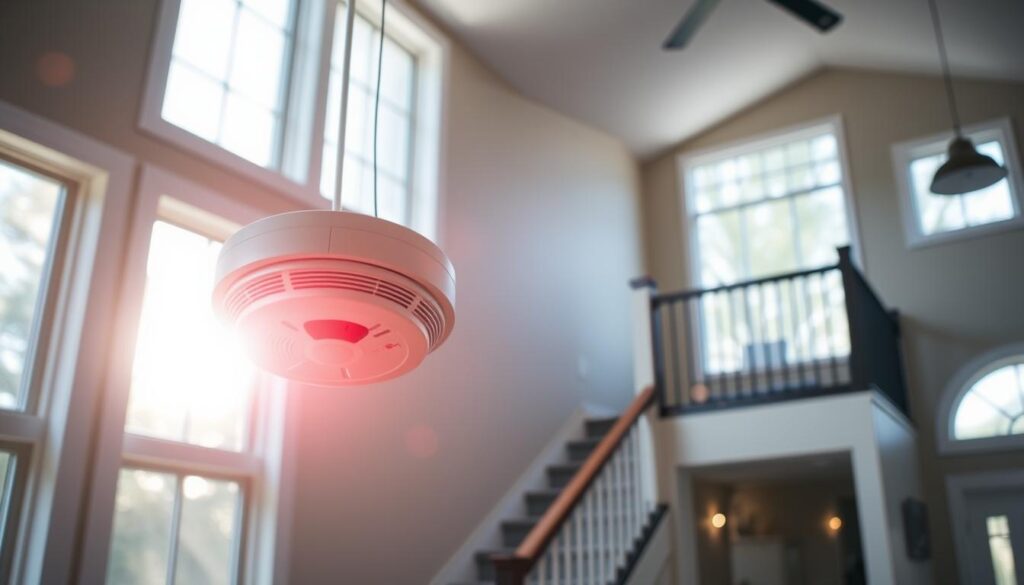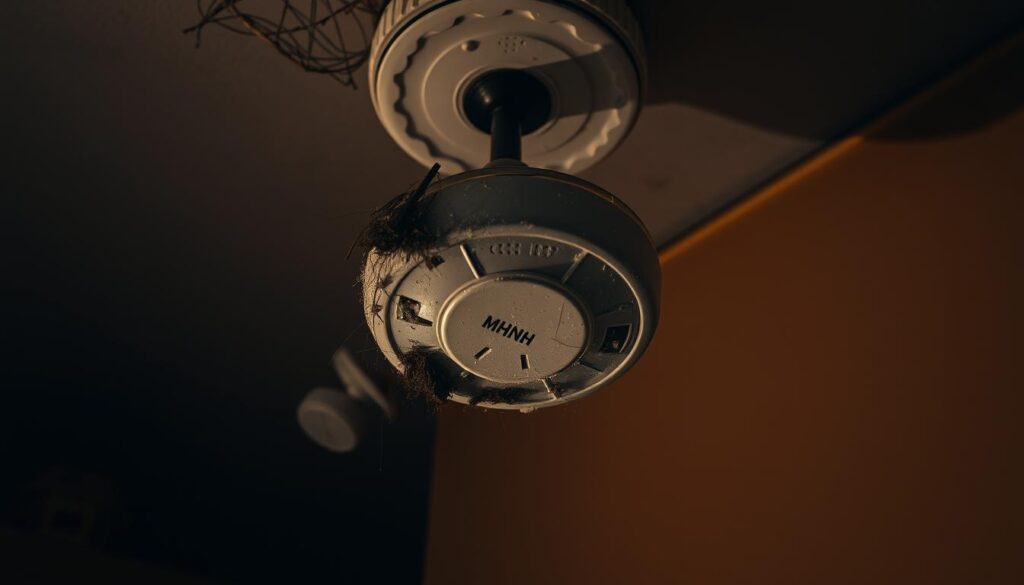Installing smoke detectors correctly is key to keeping your home safe from fires. This guide will show you how to place smoke alarms for the best protection. Canadian rules say they should be near bedrooms and common spots. But, placing them in the right spots can save lives even more.
It's also important to test them often and get them installed by a pro. This keeps your fire detection system working well.
Key Takeaways
- Smoke alarms must be installed inside and outside every sleeping area.
- Canadian building codes require placement on every level, including basements.
- Interconnected systems ensure simultaneous alerts across the home.
- Avoid areas near windows or vents to prevent air flow interference.
- Professional installation ensures compliance with safety regulations.
Understanding the Critical Role of Smoke Detectors in Home Safety
Smoke detectors are more than devices—they are key for residential fire protection. They save lives by detecting fires early. In Canada, homes with working alarms have a 47% higher survival rate than those without.
This section looks at how placement and technology boost safety.
“Every minute counts. Properly installed smoke alarms can provide critical extra time to escape.” — Canadian Fire Chiefs Association
Fire safety statistics show the urgency: over 20,000 residential fires happen each year in Canada. But homes with working alarms see 50% fewer deaths. These numbers show how smoke alarm effectiveness can prevent tragedies.
Data from the National Fire Protection Association shows detectors reduce fire deaths by 30% when maintained right.
Choosing the right smoke detector types is crucial. Here's how they differ:
- Photoelectric: Best for smoldering fires (e.g., in bedrooms). Detects visible smoke particles.)
- Ionization: Faster at sensing flaming fires (kitchens, garages).
- Dual-sensor: Combines both technologies for broad coverage.
- Smart alarms: Connect to networks for remote alerts and battery backups.
Canadian standards require at least one alarm on every floor and near sleeping areas. While international norms vary, Canada mandates photoelectric types in new builds. Proper selection and placement of these smoke detector types ensure early fire detection. This turns seconds into lifesaving advantages.
Recommended Smoke Detector Placement by Floor Level

When it comes to floor-specific smoke detector installation, each floor is different. Start with the basement smoke detector placement. Place them near utility spots like furnaces but at least 3 feet away to avoid steam issues. Also, put detectors at the bottom of stairwells to warn upper floors of basement fires.
In main living areas, the kitchen smoke alarm location is key. Keep alarms 10 feet from cooking areas to cut down on false alarms. Use photoelectric models to tell smoke from cooking fumes. For bedroom smoke detector requirements, put devices 6–12 inches from the ceiling in each bedroom. Also, have extra detectors outside sleeping areas to alert everyone.
- Basement: 3 ft from utilities, stairwell coverage
- Main Floor: 10 ft from kitchens, photoelectric sensors preferred
- Bedrooms: Ceiling-mounted inside rooms plus hallway units
For multilevel home protection, link all alarms so one triggers all. Test them monthly and replace batteries yearly. Use one detector per 600 sq ft of living space. Open-concept homes might need more units for big areas. Unfinished attics need detectors near stairs, and vaulted ceilings need them 12 inches below the peak to catch smoke.
Professional Smoke Detector Installation Guidelines and Best Practices
Proper smoke detector placement is key. It must follow strict guidelines. Professional installers make sure they work right, meeting Canadian safety rules. Important aspects include smoke detector installation height, spacing, and how they connect.
Ceiling vs. Wall Mounting: Which Is More Effective?
Ceiling mounting is best because smoke goes up. Wall mounts need to be 4–12 inches from the ceiling. But, rooms with high ceilings or blockages might need wall mounts for better smoke alarm mounting techniques. Make sure to avoid corners to keep air flowing.
Minimum Distance Requirements from Walls and Corners
- Ceiling-mounted detectors should be at least 4 inches from walls to avoid dead air space prevention issues.
- Wall-mounted units need 4 inches of space between the top of the device and the ceiling.
- Keep 3 feet away from windows, doors, or vents to prevent airflow interference.
Avoiding Dead Air Spaces Where Smoke May Not Reach
“Dead zones occur where air stagnates, delaying detection. Strategic placement is critical.”
Peaked ceilings, corners, and HVAC vents can trap air. Move detectors to ensure smoke reaches them. For sloped ceilings, place them in the middle for full coverage. Regular checks help ensure no gaps.
Interconnected Systems for Comprehensive Home Coverage
An interconnected smoke detector system makes all alarms go off at once. Hardwired systems with battery backup meet Canadian electrical codes. Wireless models offer more flexibility. Professional installers set up systems to work well, even in older homes.
Areas to Avoid When Installing Smoke Detectors
Smoke detector installation mistakes often come from improper smoke alarm placement. Stay away from these high-risk zones for reliable protection:

- Bathrooms and Laundries: Steam or appliance humidity can cause false alarm prevention failures. Use heat detectors in these areas instead.
- Close to Kitchens: Keep alarms at least 10 feet from cooking appliances to avoid smoke detector interference from cooking fumes.
- Garages: Exhaust fumes and temperature changes make garages unsuitable. Use detectors rated for these environments or place them away from direct exhaust paths.
- Airflow Obstructions: Avoid placing detectors near windows, vents, or fans. Moving air can disrupt smoke detection, worsening installation don’ts.
Extreme temperatures in uninsulated exterior walls or attics can damage electronics. Choose interior wall placements in Canadian homes where temperature changes are common. Smoke detector installation mistakes like these can compromise safety—follow manufacturer guidelines and seek professional advice for false alarm prevention.
“Incorrect placement is a leading cause of detector failure.” — National Fire Protection Association
Follow these installation don’ts to prevent gaps in coverage. Combine with regular testing and battery checks for full protection.
Conclusion: Creating a Comprehensive Smoke Detector Safety Plan for Your Canadian Home
Keeping smoke detectors in good shape is key. Test them every month and change the batteries twice a year. Also, swap out old units every 10 years to stay safe.
Having a fire evacuation plan is crucial. Make sure everyone knows how to get out of each room. Pick a safe spot outside to meet up. Practice drills to make sure everyone knows what to do.
Don't forget about fire extinguishers and carbon monoxide alarms. You might need escape ladders for upper floors. Check out free resources from your province's fire marshal or local fire department for more help.
Rental homes and new builds must follow fire codes. If your home is complex, get a pro to install smoke detectors. The National Fire Protection Association has more tips to keep you safe.
FAQ
Where should I install smoke detectors in my home?
Install smoke detectors on every level, including the basement and attic. Also, put them inside each bedroom and outside sleeping areas. This ensures maximum protection.
How far should smoke detectors be from cooking appliances?
Keep smoke detectors at least 10 feet away from cooking appliances. This prevents false alarms from cooking smoke or steam.
Do smoke detectors work in high humidity areas like bathrooms?
No, avoid installing smoke detectors in humid areas like bathrooms and laundry rooms. Use heat detectors instead to avoid false alarms.
What types of smoke detectors are best for different areas of the home?
Photoelectric smoke detectors are good for bedrooms because they detect smoldering fires well. Ionization smoke detectors are better for kitchens because they quickly spot fast-burning fires.
What is the importance of interconnected smoke detector systems?
Interconnected systems mean all alarms sound when one detects smoke. This provides greater safety for everyone, no matter where they are in the home.
How can I ensure that smoke detectors are correctly placed to avoid dead air spaces?
Smoke detectors should not be in corners, near ceiling fans, or air vents. Place them at least 4 inches from walls and corners to ensure smoke can reach them.
How often should I test and replace smoke detectors?
Test smoke detectors monthly and replace batteries every two years. Replace the whole unit every 10 years to keep them working well.
Can I install smoke detectors on uninsulated exterior walls?
It's not a good idea to install smoke detectors on uninsulated exterior walls. Temperature changes can cause damage. They should be in stable temperature areas.
What additional safety precautions should I consider beyond smoke detectors?
Use carbon monoxide detectors, fire extinguishers, and make a detailed evacuation plan. Include multiple escape routes and meeting points for family members.



